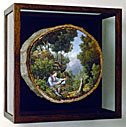|

Comment
on this story
What:
Beyond the Frame: James Dustin and Alison Moritsugu
Where:
Knoxville Museum of Art, 1050 World's Fair Park Drive
When:
through July 8
|
|

KMA takes us beyond canvas
by Heather Joyner
If you have ever been to a concert and ended up enjoying an opening act more than the top-billed event, what follows will make sense. The KMA's ongoing Beyond the Frame exhibits, however secondary to glitzier shows, are not to be missed. There's no shame in visiting the museum to see specific works by M. C. Escher or Dale Chihuly, but to overlook the Lucille S. Thompson Family Foundation Gallery on the way to Warhol's World would be a shame—for downstairs is where we find contemporary artists who may eventually be superstars themselves.
Now halfway into a second year, the Beyond the Frame series has been consistently unusual and intriguing. Assembled by KMA Assistant Curator Nandini Makrandi, it proves that lesser-known artists indeed have opportunities to shine (those awaiting a first big break might be interested in learning that at least two BTF artists were contacted after sending promotional material to the museum). One needn't run with a particular New York crowd or even have a rep; a simple stamped postcard can catch the KMA's collective eye and lead to an exhibit.
Pairing James Dustin and Alison Moritsugu, the current show features works on gessoed wood. For Moritsugu, that means wood in the form of log "slices" and stumps. Her message concerning our often mindless domination of nature might be too simplistic if she weren't so cleverly blatant in the execution of her driving concept. Dustin's use of wood for painting surfaces is less symbolic, but given that his pieces are components of larger, sometimes patchy grids, it lends solidity. Similarly-sized canvases would not reflect the very materials of buildings Dustin depicts, nor would they possess such weight against the gallery walls.
Despite—or perhaps due to—graduating from the Maine College of Art in 1981, Dustin is fascinated with the urban environment and often paints atop his home in Brooklyn. At first glance, his strict organization of space that generally revolves around man-made things may seem a bit stiff. Yet upon closer inspection, we notice an impressionistic sense of light and a painterly approach that suggests constantly shifting vision. Dustin's recent "Pavilion Paintings" juxtapose fixed spaces with scenes beyond, and his loose approach to the latter appears to be a statement regarding his own struggle with artistic control and surrender. Scale becomes irrelevant as he acknowledges art's essential removal from reality. Whether we are looking at Dustin's clustered industrial roof trusses, his Civil War Series IV; Fields & Chimneys, or his sketchy multiple images of plane crashes (not terribly unlike Warhol's car wreck prints), we perceive a solemn beauty found in that which relates to human beings but is entirely without their actual presence. Likewise, his Cabinet Men III—with its numerous immigrant faces from old photographic portraits found in flea markets—depicts souls that are no more, and it reminds us of our inability to reach back into the stream of time.
Of her work, Moritsugu says, "When a wooded landscape reminiscent of a Cole or Bierstadt seems more familiar to us than the decaying log on which it is painted, it becomes evident that we must establish a relationship with nature that comes not from idealized imagery, but from dirt, wood, decay, and a more direct and humble interaction with the earth." As a native of the much-exploited island "paradise" that is Hawaii, she is understandably obsessed with environmental themes. But subject matter aside, it is Moritsugu's innovative use of raw wood as a base for her images that sets her apart. At times arranging more than a hundred perfectly cut log slices of identical thickness in groupings, she turns whimsy on its head. Although there's something vaguely cheesy about Moritsugu's colors and scenes of 19th Century couples cavorting in the forest, they project a brand of humor that sizzles with sarcasm and scary absurdity. For some people, that approach might not inspire ecological sensitivity, but it's at least memorable.
In her statement about Moritsugu's work, Makrandi has written, "Americans have had a romance with their country, perpetuated by their belief in Manifest Destiny—that it was not just a person's right, but duty, to make use of the land as God intended....these romantic ideas of nature uncultivated by man, of placid, pristine, untroubled vignettes of natural abundance further perpetuated the idea that the land was limitless in its ability to support man's endeavors....[such ideas also worked to publicize] a 'vast new real estate market.'" Be that as it may, Makrandi refers to Moritsugu as "a different kind of publicist" and sees her log sections as being "tiny trophies of the earth, much like trophy heads of large animals."
No matter what their respective "causes," both Dustin and Moritsugu motivate us to think by first appealing to our senses. And they do so in a way that is original as well as skillful.

May 31, 2001 * Vol. 11, No. 22
© 2001 Metro Pulse
|